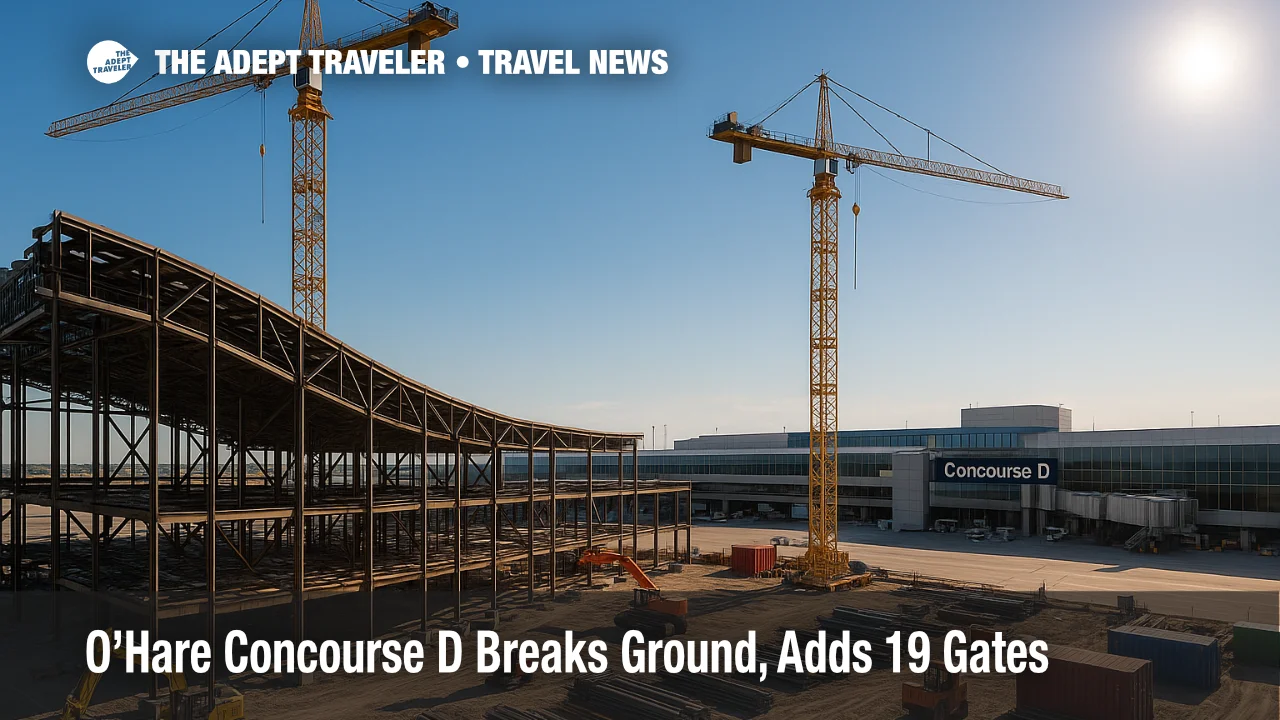O'Hare Concourse D Breaks Ground, Adds 19 Gates

Chicago O'Hare International Airport (ORD) has started construction on Concourse D, a $1.3 billion expansion that kicks off the airport's next major growth phase. The 590,000-square-foot building will add 19 gates, more than 20,000 square feet of lounge space, and about 30,000 square feet for shops and dining. Designed by SOM with Ross Barney Architects, JGMA, and Arup, the concourse centers on a 40-foot atrium with an oculus, tree-like columns, and broad, column-free gate areas to improve flow. The project targets completion in late 2028.
Key Points
- Why it matters: First new concourse at O'Hare in more than 30 years, adding capacity and comfort.
- Travel impact: 19 gates with flexible layouts improve connections and reduce bottlenecks.
- What's next: Concourse E, the O'Hare Global Terminal, and an all-access underground tunnel follow.
- Design highlight: Daylit atrium, column-free lounges, and nature-forward interiors.
- Budget: $1.3 billion for Concourse D within the broader ORDNext program.
Snapshot
Concourse D sits just south of Terminal 1 and will ultimately link with other ORDNext elements to streamline curb-to-gate movement. The three-level plan features a long-span roof that halves the number of support columns, opening sightlines and improving wayfinding. At the north end, a 40-foot atrium with an oculus pulls daylight into all levels and frames views of the Chicago skyline. Interiors echo Midwestern river curves, adding warmth with natural materials and landscaped seating. Amenities include expansive lounges, new retail and dining, and family-friendly spaces, all intended to reduce stress and improve dwell time quality for travelers.
Background
O'Hare handled more than 80 million travelers in 2025's peak months, reinforcing its role as a global hub for United and American. To keep pace, the City of Chicago and the Chicago Department of Aviation launched ORDNext, a decade-scale modernization that replaces Terminal 2 with the O'Hare Global Terminal, builds two satellite concourses, and connects them with a new underground tunnel for passengers, employees, and baggage systems. Terminal 5's expansion is already complete, and Terminal 3 improvements continue. Concourse D is the first satellite to rise, establishing the operational flexibility needed to phase construction of the Global Terminal without cutting gate capacity.
Latest Developments
Design focuses on daylight, flexibility, and calmer gate areas
The design team, led by Skidmore, Owings & Merrill, uses a curved, long-span roof and tree-inspired columns to create large, column-free lounges and clear sightlines. The 40-foot-tall atrium with an oculus delivers natural light to all three levels, aligning with traveler comfort goals like easier wayfinding and better air circulation. The gate plan is optimized for narrowbody aircraft, with flexibility to reconfigure most positions into larger bays for widebodies as needed. A sweeping glass wall brings in skyline views, while landscaped seating areas and a children's play zone make waits more relaxing.
Phasing under ORDNext, with completion targeted for 2028
Concourse D is the first of two satellites, with Concourse E planned to follow west of D after 2028. The wider ORDNext program replaces Terminal 2 with the O'Hare Global Terminal and adds an underground tunnel connecting new and existing facilities, improving transfers and baggage routing. Funding is backed by the City in partnership with airline stakeholders, with construction sequencing designed to keep operations stable through the build. Groundbreaking occurred on August 18, 2025, and late-2028 remains the stated completion target for Concourse D.
Analysis
Concourse D is a capacity and quality-of-experience play that acknowledges two realities at O'Hare. First, the hub's banks and irregular operations demand more flexible gate space where multiple aircraft types can be turned efficiently without clogging alleys or lounges. Second, travelers now expect daylight, greenery, and intuitive circulation on par with high-performing global hubs. The long-span structure, reduced columns, and daylit atrium address both, creating room to breathe while preserving operational discipline. Strategically, sequencing D ahead of the O'Hare Global Terminal avoids a gate crunch and enables smoother airline relocations when Terminal 2 is demolished. Risks center on multi-year construction in a live, weather-sensitive operation, where schedule slippage can ripple into costs and airline gate plans. Still, the mix of added gates, better circulation, and integrated amenities should pay off in shorter dwell pains and improved on-time performance once D opens.
Final Thoughts
With Concourse D, O'Hare resets expectations for a busy U.S. hub by pairing capacity with traveler-centric design. The daylighting strategy, flexible gates, and intuitive circulation speak to lessons learned from newer international terminals, while the orchard-inspired structure nods to ORD's history. As ORDNext advances to Concourse E and the O'Hare Global Terminal, this first satellite will be the proof point that Chicago can modernize without sacrificing reliability. If delivery holds for late 2028, travelers should feel the difference in fewer chokepoints and more comfortable waits, validating the investment in O'Hare Concourse D.
Sources
- Mayor Brandon Johnson Breaks Ground On The New Concourse D, City of Chicago
- The New Concourse D, ORDNext
- ORD 21 Program Overview, Chicago Department of Aviation
- O'Hare International Airport, Concourse D Project, SOM
- O'Hare breaks ground on Concourse D, Axios Chicago
- $1.3B Concourse D Expansion Breaks Ground, Engineering News-Record
